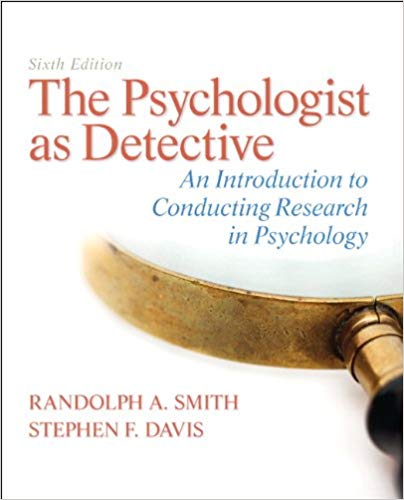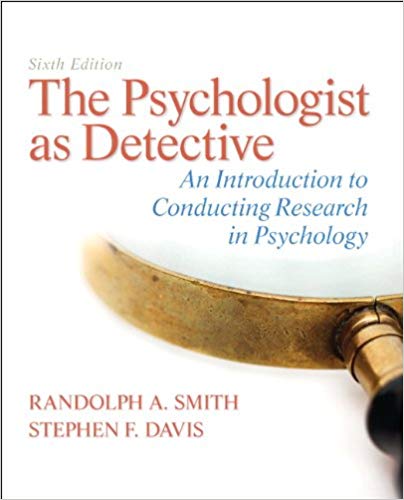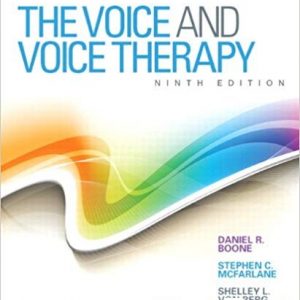Instant download Test Bank for The Psychologist as Detective: An Introduction to Conducting Research in Psychology 6th Edition pdf docx epub after payment.

CHAPTER 1: PSYCHOLOGICAL RESEARCH AND THE RESEARCH METHODS COURSE
Activities/Assignments
Scientific Thinking. Hatcher (2000) presents an activity to introduce scientific thinking, perhaps as an icebreaker on the first day of class. Students are given a riddle and can ask yes/no questions until they come up with the right solution. Hatcher points out the similarities between solving riddles and scientific thinking (e.g., “Persistence is a key quality in problem solving,” “By expecting complicated answers, simple ones may be overlooked,” p. 123). Hatcher reports that students enjoy the exercise and that it works well as an icebreaker activity.
Hatcher, J. W. (1990). Using riddles to introduce the process and experience of scientific thinking. Teaching of Psychology, 17, 123-124.
The Research Process: An Overview. Wilson and Hershey (1996) describe an activity designed to help students discover that they know more about the research process than they may think they do. Students are given a sheet of paper with the phrase “Get idea for project” at the top and “Publish the research paper” at the bottom. Students are to fill in any activities that they think occur between these two steps. Their answers are then compared to the answers provided by 49 psychology professors. I’ve found that this activity works nicely as a first-day icebreaker – students can work in small groups and thus meet some of their classmates.
Wilson, T. L., & Hershey, D. A. (1996). The research methods script. Teaching of Psychology, 23, 97-99.
The Research Process for an Original Research Project. It’s often instructive for students themselves to go through the components of the research process as seen in Table 1-2 (p. 4). Students can go through the first 4-5 components (Problem, Literature Review, Theoretical Considerations, Hypothesis, and Research Design) for a topic of interest to them (see handout entitled The Research Process for an Original Research Project).
Becoming a Knowledgeable Consumer of Research. Connor-Greene (1993) describes an interesting activity designed to help students think critically about popular press articles that depict psychological research. During class in small groups, students read a short USA Today article on biological differences between homosexual and heterosexual men (the article is conveniently reprinted in the Appendix of Connor-Greene’s article). Students answer six questions and then view excerpts of the research article from which the USA Today article is based. An individual assignment is also discussed; students themselves can find a popular press article describing research and then compare to the original research report.
Connor-Greene, P. A. (1993). From the laboratory to the headlines: Teaching critical evaluation of press reports of research. Teaching of Psychology, 20, 167-169.
Article Review. Each chapter in this Instructor’s Manual contains an “Article Review” in which students read an empirical journal article and answer questions. The articles have been chosen based on several factors. First, each article should be easily comprehended by students. Many of the articles are older, in part because older articles tend to have somewhat simpler methodologies (only one or two independent variables, only one study presented, etc.). Second, each article should be interesting to students. Topics include, for example, sexual attraction, helping behavior, and attitudes toward gay men and lesbians. Third, each article should be related to the chapter topic. For example, in the ethics chapter (Chapter 2), students will read an article containing deception. In the survey chapter (Chapter 4), students will read an article containing a telephone survey. Fourth, each article should be related not only to the chapter in which it is presented, but also to past and future chapters. For example, many of the studies contain deception so that instructors can revisit ethics throughout the course. Many of the questions for each article review reference material from past chapters, so if you cover chapters out of order, be aware that you may need to modify this activity accordingly.
Students need to have access to the full text of the articles in order to answer the questions, so instructors could either make the articles available (e.g., on Reserve at the library) or have students find the articles themselves at their library (this may not be feasible if students need to use Interlibrary Loan).
The article for Chapter 1 is on handshakes and how aspects of the handshake (e.g., strength, vigor) relate to gender, personality, and first impressions.
The questions for this Article Review focus primarily on the components of the research process (see Table 1-2 on p. 4). There is some deception in this study, so it could be used in Chapter 2 as well. In addition, a correlational research design is used, so this article could be used in Chapter 4.
Chaplin, W. F., Phillips, J. B., Brown, J. D., Clanton, N. R., & Stein, J. L. (2000). Handshaking, gender, personality, and first impressions. Journal of Personality and Social Psychology, 79, 110-117.
Discovering Psychology: Understanding Research. This program provides an overview of the research process and is available free online at http://www.learner.org/resources/series138.html.
The Research Process for an Original Research Project





